Urban Visualization I
Flows, Time & Interactivity (2D + Time) - CS-GY 6313 - Fall 2025
2025-10-31
From Static Maps to Dynamic Urban Systems
The Yellow Blob Problem
What happens when we apply static techniques to massive urban datasets?
This is 140 million NYC taxi trips visualized as a static heatmap.
What can you learn from this?
Nothing. It’s a “yellow blob.”
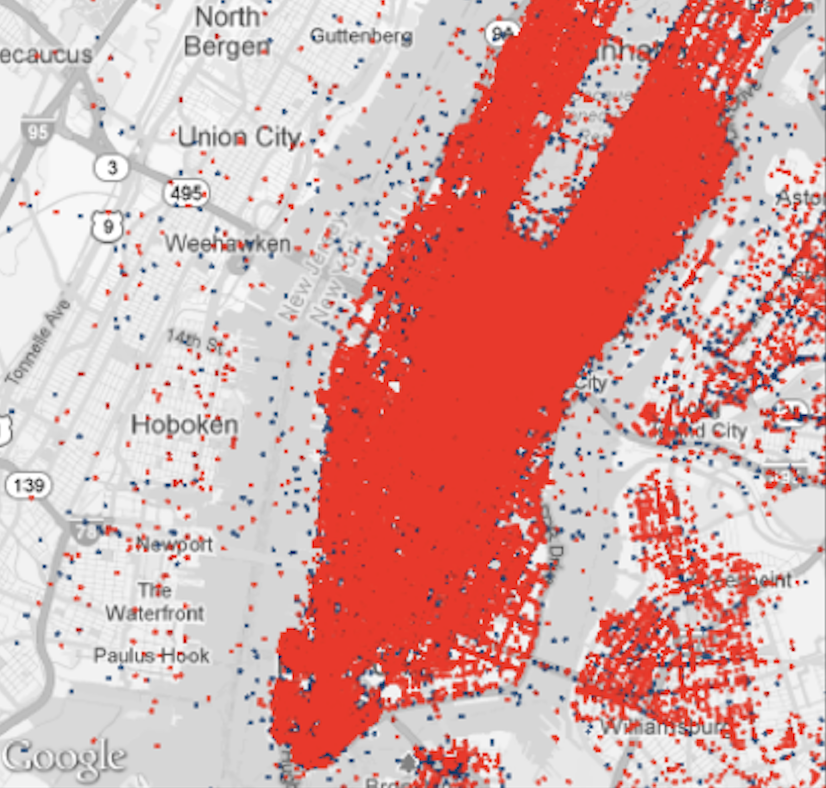
Today’s Goal
Learn to visualize urban dynamics—movement and time—using interactive, linked views
- Challenge: Urban data is massive, dense, and dynamic
- Solution: Turn visualization into an exploration tool
- Case Study: TaxiVis—a system for exploring NYC taxi flows
We’ll learn how to move from this “yellow blob” to meaningful insights about urban mobility patterns.
Part 1: The Urban Context
Why This Matters
The Urban Challenge:
- Over 50% of world’s population in cities
- +2.5 billion more by 2050
- Cities = centers of innovation
- But also: sprawl, pollution, inequality
How do we make better decisions about urban development?
The Data Opportunity:
- We can now collect, store, and open massive urban datasets
- Benefits:
- Government: Operations & planning
- Science: Discovery
- Residents: Participation
- Industry: Innovation
What Makes Urban Data Unique?
Three Interacting Components:
- Residents - People and their behavior
- Infrastructure - Physical systems and policies
- Environment - Natural and built surroundings
To understand a city, we must explore how these interact over space and time.
Four Key Characteristics:
- Scale
- Human-level to metro-level
- Millions of individual events
- Density
- Massive overplotting
- Traditional techniques fail
- Complexity
- Interconnected systems
- Transit, traffic, social networks
- Dynamism
- Cities defined by time & movement
- Static snapshots miss the essence
Hägerstrand’s Space-Time Cube (1970)
The Classic Framework for Movement Analysis
- X, Y dimensions: Geographic space
- Z dimension: Time
- Each person’s life: a line through the cube
The Urban Challenge:
Understanding millions of these paths, all interacting simultaneously
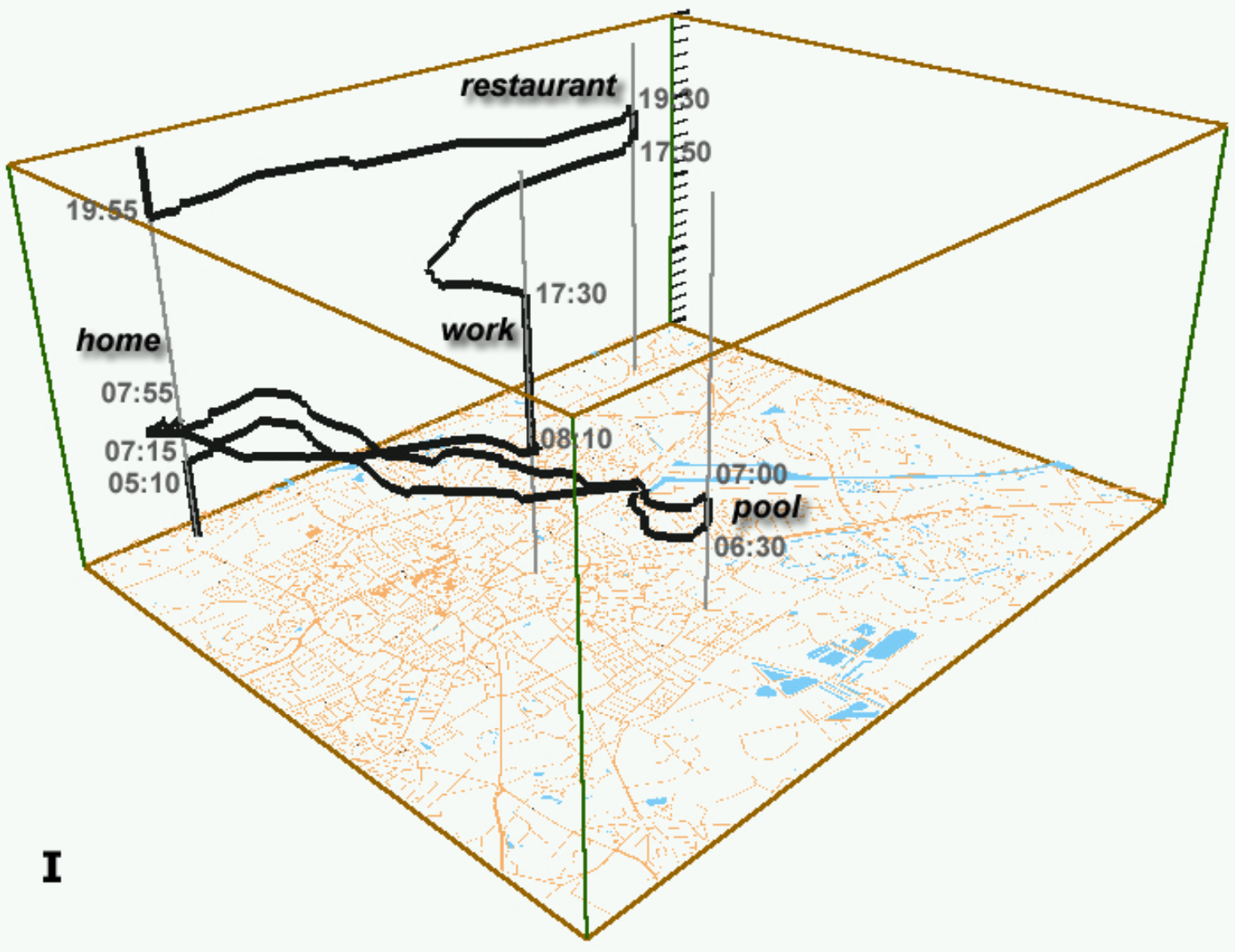
Part 2: Why Traditional Analysis Fails
The Old Workflow (Confirmatory Data Analysis)
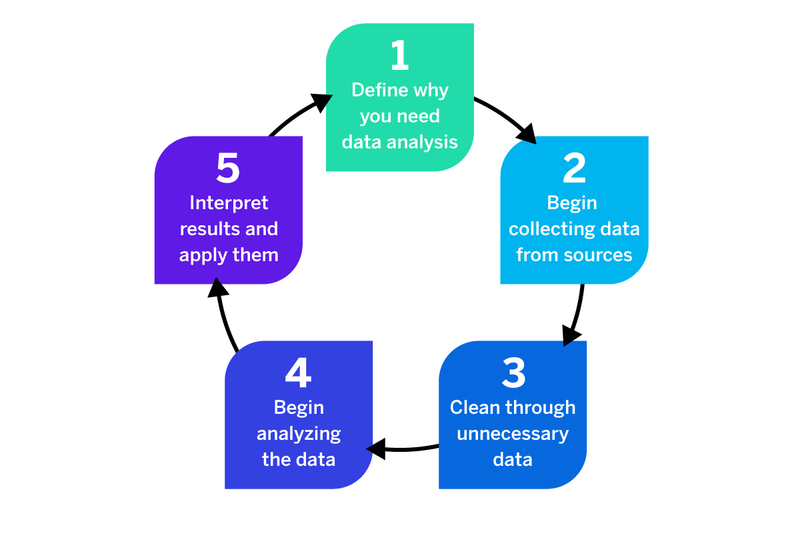
The Process:
- Domain experts formulate hypotheses
- Data scientists select data
- Run analyses (SQL, R, Python)
- Domain experts inspect results
- Repeat…
The Problems with Traditional Workflows
❌ Cognitive overload - Generates overwhelming numbers of plots/tables
❌ Batch-oriented - No exploration, just predetermined queries
❌ Distances experts from data - Requires intermediary (data scientist)
❌ Cannot scale - Modern data volumes overwhelm traditional tools
❌ Result: The “yellow blob” problem
Even simple questions require generating dozens of individual plots, each manually programmed
The Problem with Current Tools
Current practice for domain experts:
- Load small slices into R, MATLAB, Stata, ArcGIS, Excel
- Write SQL queries or code to analyze subsets
- Generate individual plots manually
- Repeat for each new question
This is tedious, slow, and limiting
Why this fails:
❌ Tools can’t handle 170M trips
❌ Requires programming/database expertise
❌ Time-consuming and frustrating
❌ Distances experts from the data
❌ Hard to explore, compare, or follow up on patterns
Part 3: The Need for Interactivity
The Paradigm Shift
Static Visualization
Role: Presentation
- Answers questions the designer anticipated
- Fixed perspective
- One-way communication
Limitation: Cannot handle 140 million data points
Interactive Visualization
Role: Exploration
- Enables users to ask their own questions
- Dynamic perspectives
- “Dialogue with data”
Power: Query and filter to reveal patterns
The Visual Information Seeking Mantra
“Overview first, Zoom and Filter, then Details-on-Demand”
— Ben Shneiderman (1996)
1. Overview

Start with the big picture (even if it’s a “yellow blob”)
2. Zoom & Filter
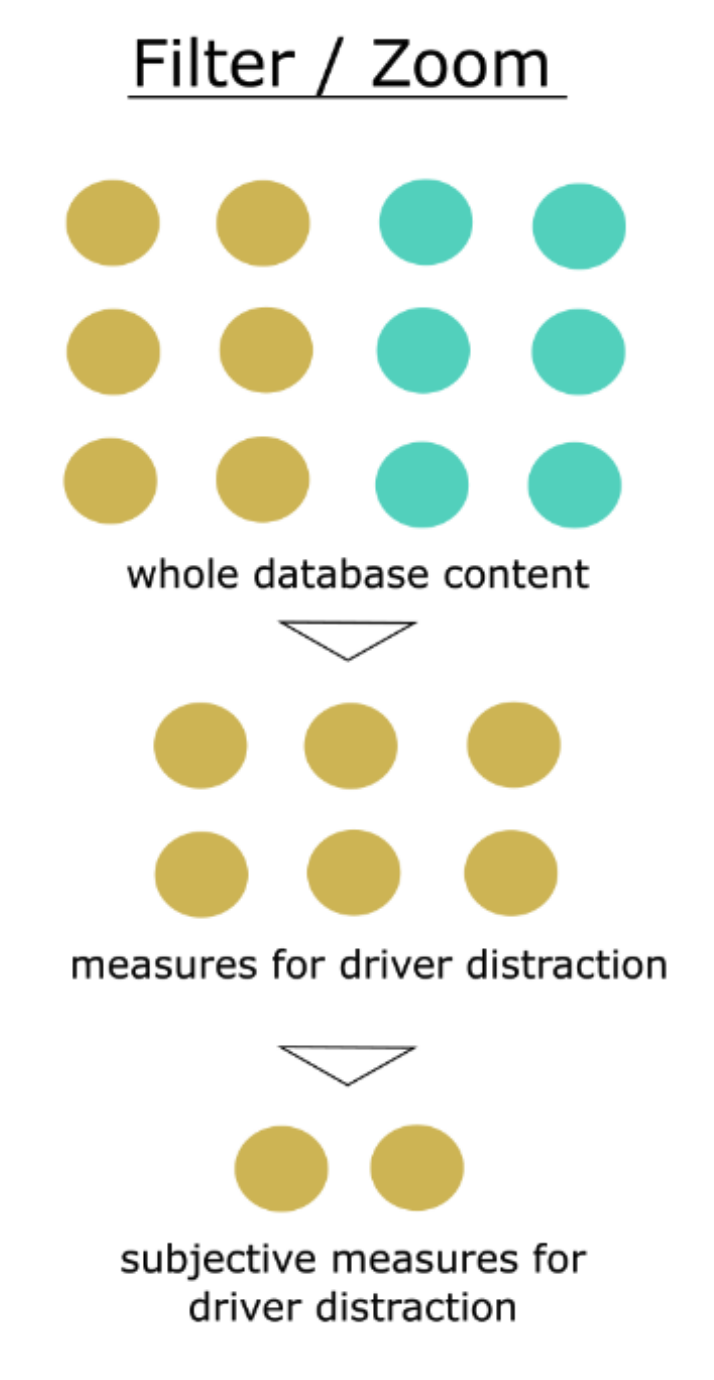
Focus on items of interest
3. Details-on-Demand

Get specifics when needed
Why Interactivity Matters
- Performance is critical
- Even 500ms latency significantly reduces exploration, observations, and hypothesis generation
- Sub-second response enables iterative analysis
- Perception over cognition
- Well-designed systems let you see patterns rather than calculate them
- Visual queries are faster than SQL
- Empowers domain experts
- No programming required
- Direct manipulation of visualizations
- Experts can explore data themselves
Research shows that even a half-second delay dramatically impacts analysis quality.
Part 4: Enter TaxiVis
The NYC Taxi Dataset
The Data:
- 13,000 taxis
- 500,000 trips/day
- 170 million trips/year
Each trip includes:
- Pickup/dropoff locations & times
- Distance traveled
- Fare amount
- Tip amount
What can taxi data tell us?
- Economic activity and human behavior
- Mobility patterns across the city
- Response to major events (hurricanes, holidays)
- Social inequalities in service
Challenge: How do we make sense of this data?
Taxi Patterns and Anomalies
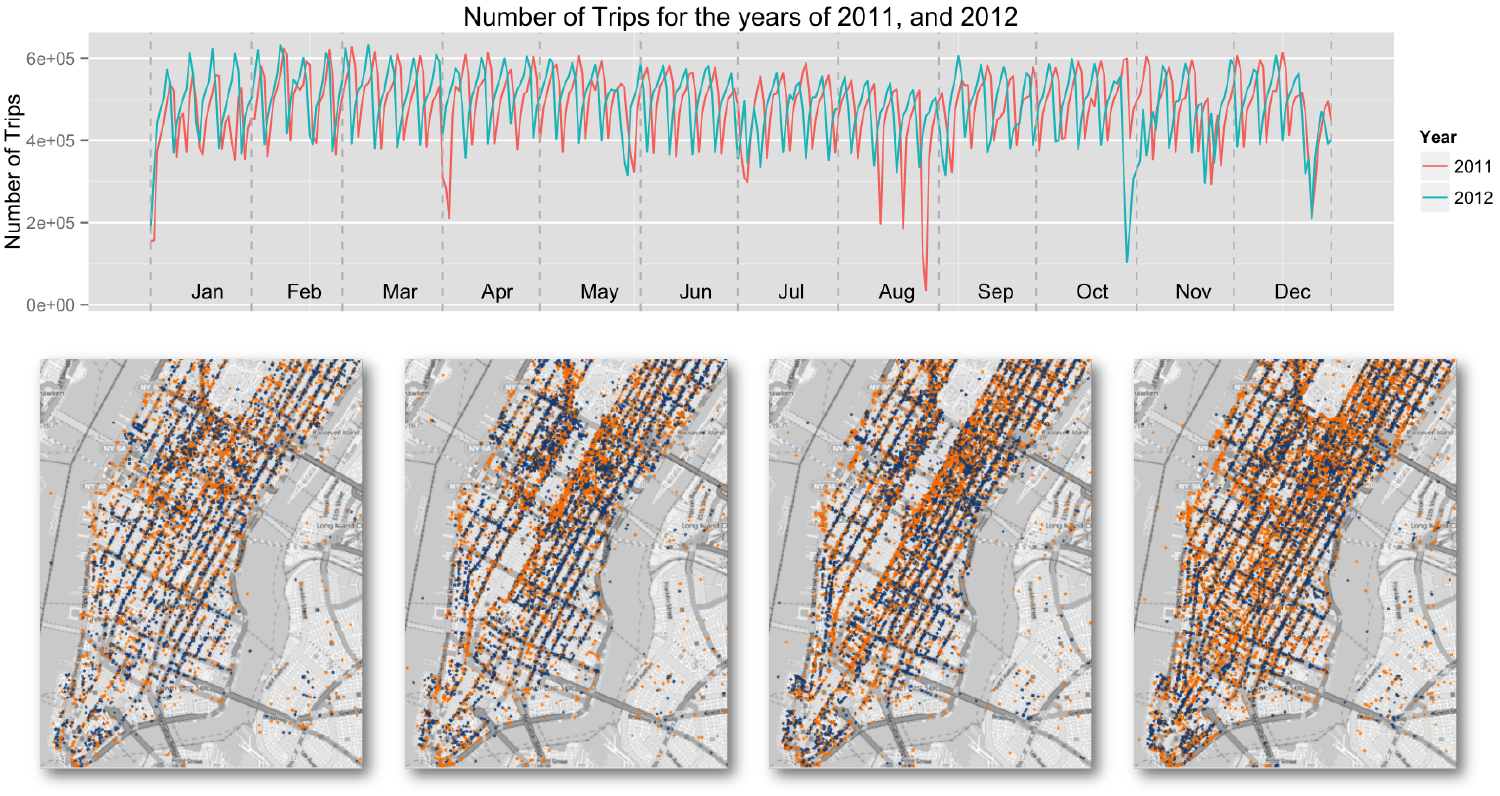
Taxi activity patterns showing regularity and anomalies
- Regular patterns: Thanksgiving, Christmas drops in activity
- Anomalies: Hurricane Irene, Hurricane Sandy disruptions
- Events: Five Boro Bike Tour (taxis disappeared along 6th Avenue)
Part 5: Design Requirements
What We Need (From Domain Experts)
Query Needs:
- Understand dynamics
- “How do patterns vary over space and time?”
- Explore events
- “What happened during Hurricane Sandy?”
- Compare regions
- “Midtown vs. Harlem taxi frequency?”
- Study movement
- “Where do people go from JFK?”
System Requirements:
- Interactive - Sub-second response times
- Expressive - Support complex spatio-temporal queries
- Usable - No SQL or programming required
- Scalable - Handle all 170M trips, not samples
- Comparative - Easy to compare regions and time periods
Part 6: The Visual Query Model
Core Idea: Direct Manipulation
Let users query data through direct manipulation of visualizations
Spatial
Where?
- Pickup regions
- Dropoff regions
- Draw polygons on map
Temporal
When?
- Time ranges
- Recurrence patterns
- Day of week
Attribute
What?
- Fare amount
- Distance
- Trip duration
Instead of writing SELECT * FROM trips WHERE..., you draw on a map
Visual Representation of Queries
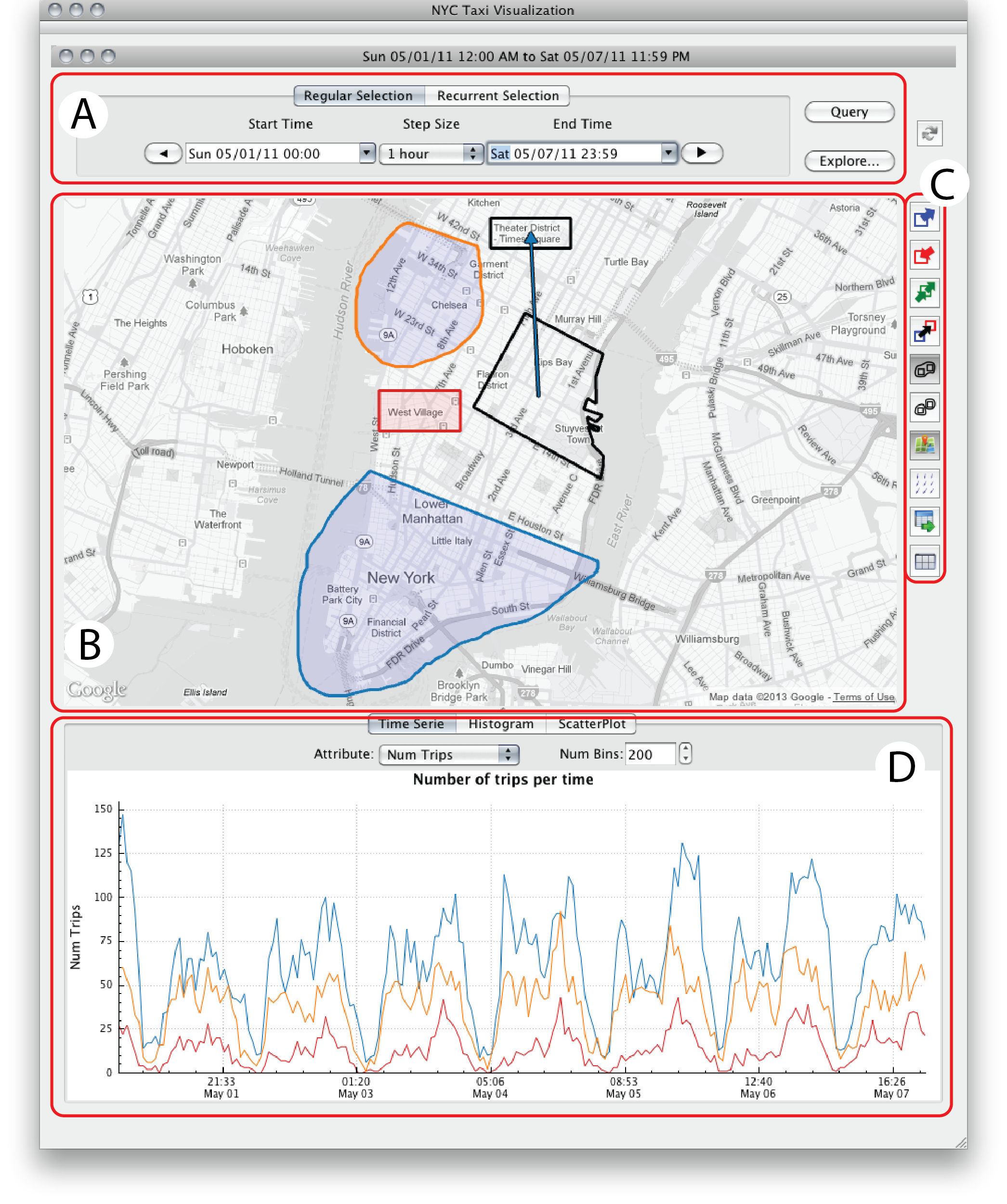
- Blue polygons on map = pickup regions
- Orange polygons = dropoff regions
- Arrows = origin-destination queries
- Time widgets = temporal constraints
- Histograms = attribute constraints
Part 7: TaxiVis Interface
The Complete System
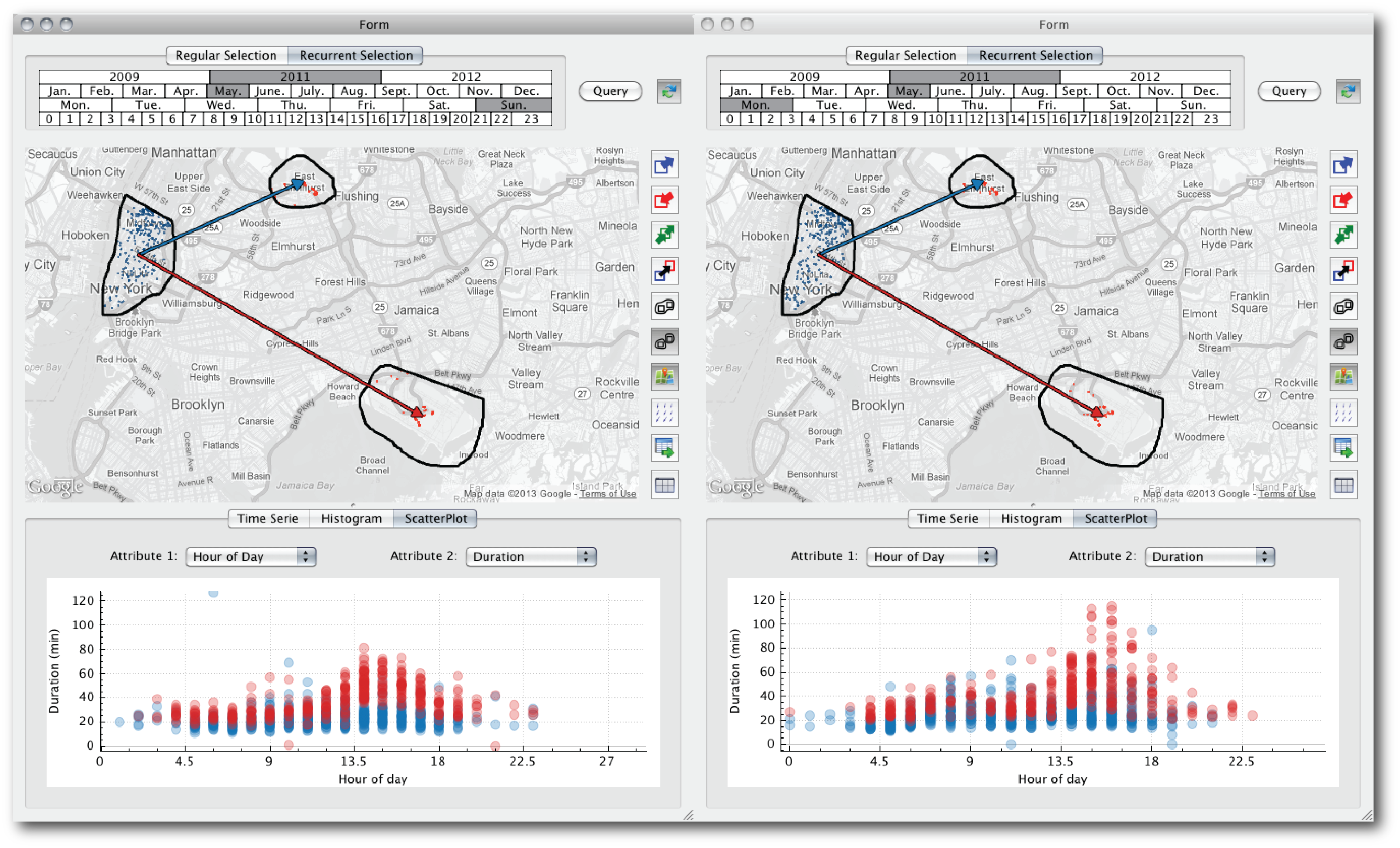
Full TaxiVis interface showing linked views
Interface Components

TaxiVis interface with labeled components
1. Map View
- Geographic visualization
- Interactive region selection
- Origin-destination flows
2. Control Panel
- Time range selection
- Query type controls
- Data aggregation settings
3. Temporal Views
- Time series plots
- Histograms
- Daily/weekly patterns
Part 8: Visual Queries in Action
Example: Airport Comparison
The Question:
“How do trips to JFK vs. LGA differ on Sundays vs. Mondays?”
The Visual Query:
- Draw region around Lower Manhattan (pickup)
- Draw regions around JFK and LGA (dropoffs)
- Connect with arrows (directional constraints)
- Select Sunday vs. Monday (temporal constraints)

The Results & Discovery

Side-by-side comparison of Sunday vs Monday airport trips
- Side-by-side map comparison
- Scatter plots: hour of day vs. trip duration
- Discovery: Monday trips 3-5PM take much longer (rush hour!)
- Implication: Creates economic disincentive for drivers to accept airport trips
Part 9: Query Expressiveness
Peuquet’s Triad Framework
All three fundamental spatio-temporal query types:
when + where → what
“What taxis were in Midtown at rush hour?”
when + what → where
“Where were high-fare trips on New Year’s Eve?”
where + what → when
“When do trips to airports peak?”
Plus: Query Composition
- Queries can be refined, combined, compared
- Results can be visualized multiple ways
- Supports both atomic queries and complex queries (unions)
Part 10: Making It Interactive
The Performance Challenge
The Problem:
- 170M trips = traditional databases too slow
- PostgreSQL: 24 seconds for 100k-trip query
- SQLite: 85 seconds for same query
- Goal: Sub-second response
The TaxiVis Solution:
- Custom k-d tree index
- 30GB vs. 200GB for PostgreSQL
- Build time: 28 min vs. 13 hours
- Query time:
- 2 seconds for 100k trips
- 0.2s for 1k trips
- Adaptive level-of-detail rendering
- Smart heat maps and aggregation
Part 11: Visualization Techniques
The “Yellow Blob” Rendering Problem
The Challenge:
- 500,000 trips/day as point cloud = complete clutter
- Can’t see patterns, just noise
- Traditional scatter plots fail at this scale
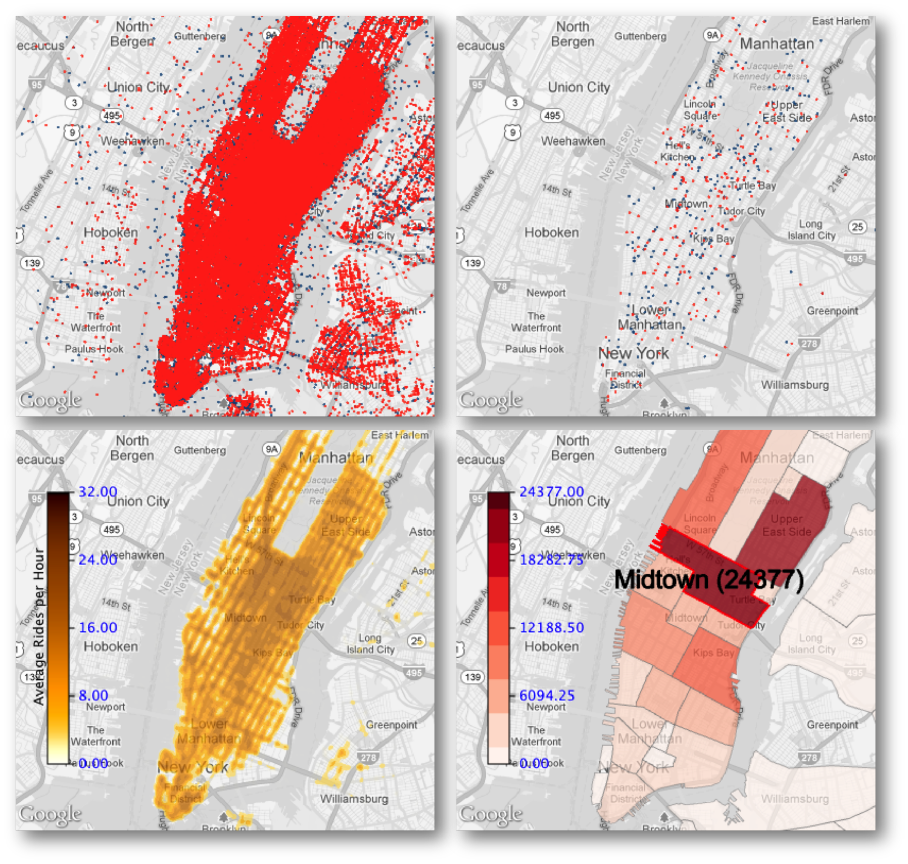
We need multiple visualization strategies
Solution 1: Adaptive Level of Detail (LOD)
Strategy: Render only what you can see
How it works:
- Z-order curve hierarchical sampling
- Sort points spatially, build binary tree
- First n elements = hierarchical subsample of size n
- n scales with zoom level
Result: Clear visualization at every zoom level
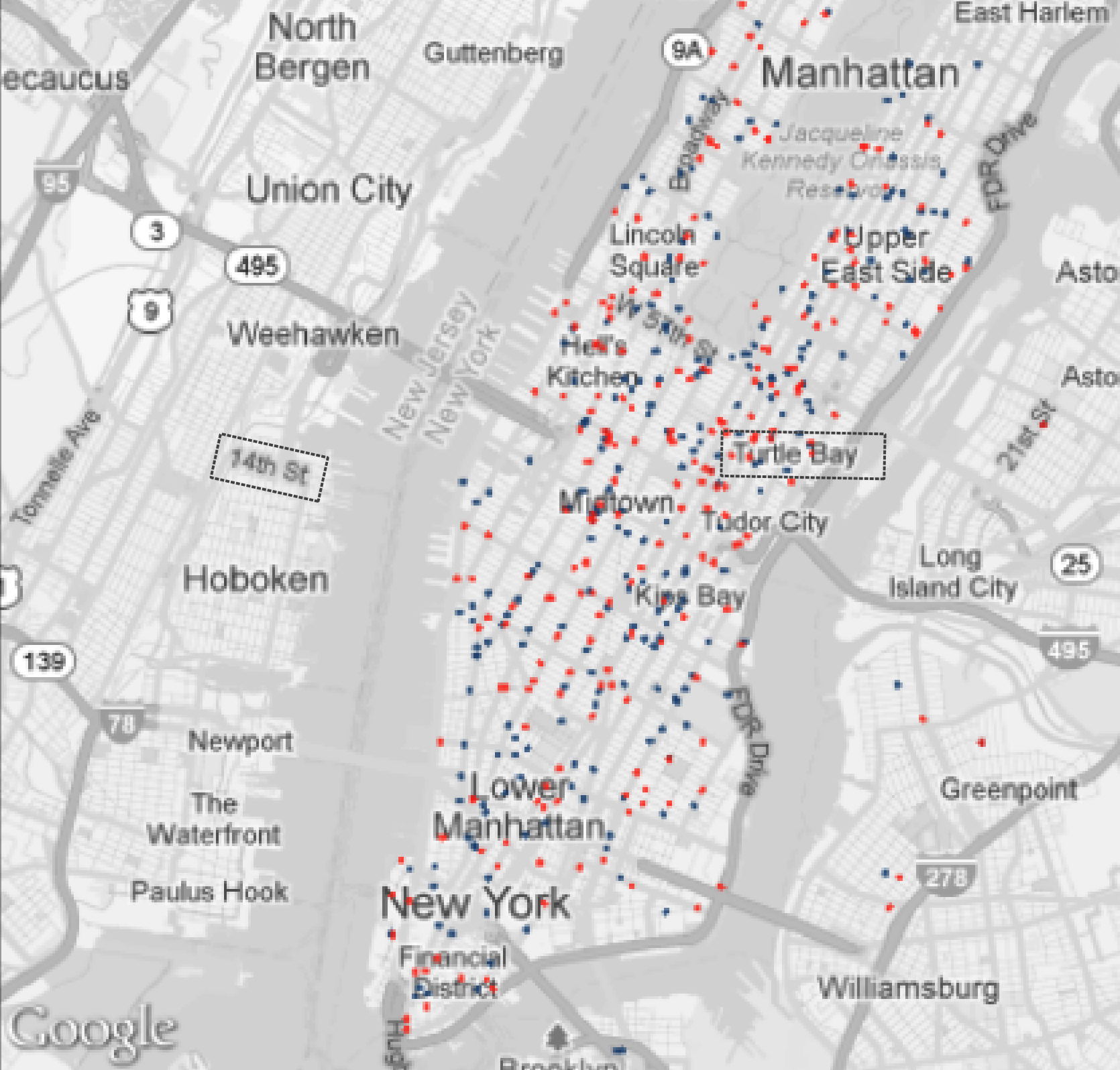
As you zoom in, you see more detail. As you zoom out, you see a representative sample.
Solution 2: Heat Maps
Continuous Heat Maps
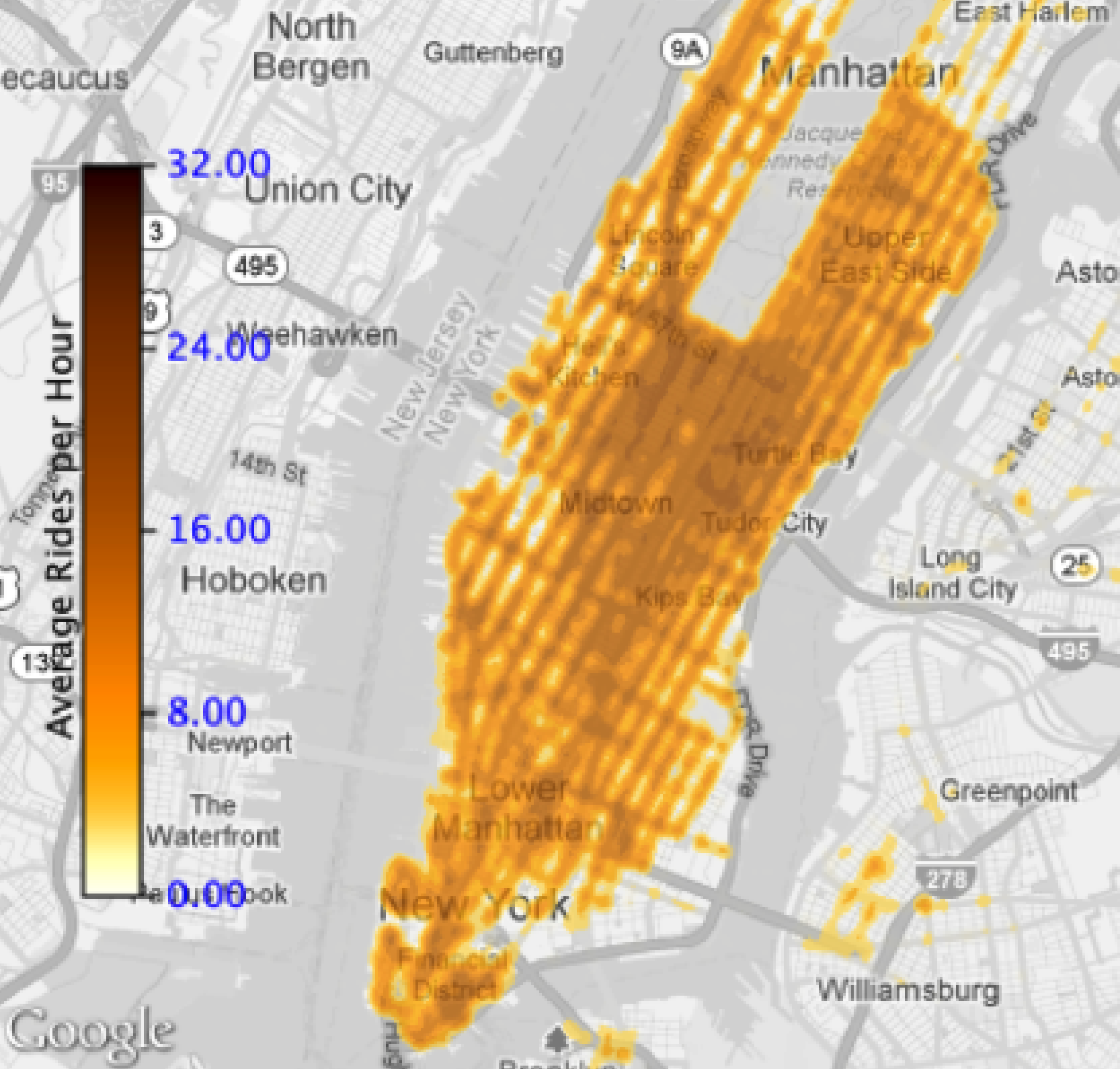
- Pixel-based density
- Darker = more activity
- Shows overall distribution patterns
Grid Maps
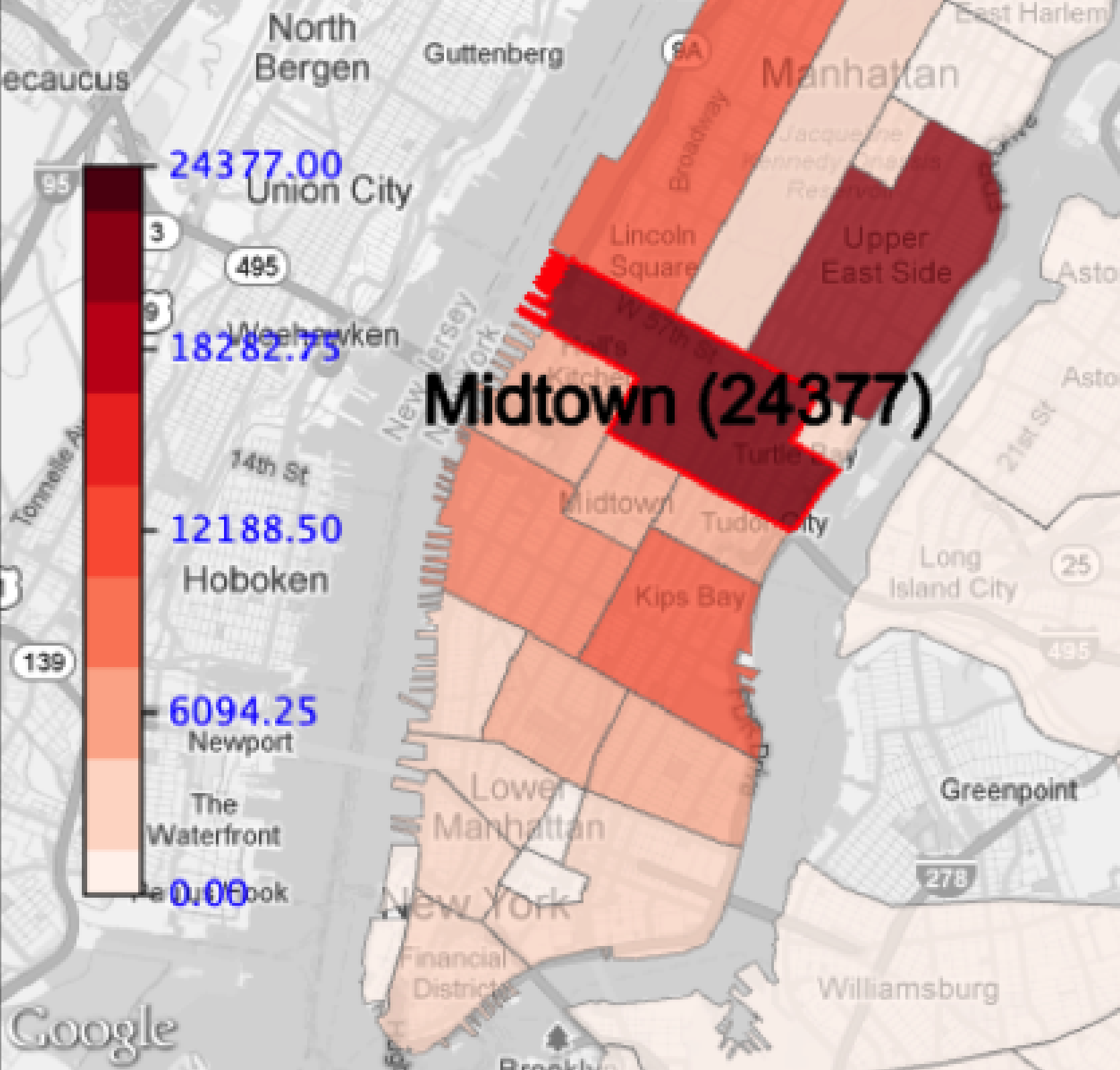
- Aggregate by meaningful regions
- Neighborhoods, zip codes, boroughs
- Hover for exact counts
When to use: Heat maps for overview and patterns, LOD for specific trip details, Grid maps for comparing defined regions
Solution 3: Multiple Coordinated Views
The Comparison Problem:
- “How do Sundays differ from Mondays?”
- “JFK vs. LGA patterns?”
- “This year vs. last year?”
Solution:
- Side-by-side views
- Each view = one query (color-coded)
- Synchronized spatial extent
- Linked plots and summaries
- Interactive refinement

Part 12: Linked Views & Brushing
Core Concept: Brushing and Linking
Actions in one view are reflected in all other views
This creates a “dialogue” where you can ask questions by interacting with any visualization component, and all views update to answer your question.
Example: Spatial Selection → Temporal Pattern
“What is the temporal pattern for trips from JFK Airport?”
Linked Views in Action: Step 1
Default View: All Data

TaxiVis showing all taxi trips
The map shows the “yellow blob”—all trips. The time series shows aggregate patterns for the entire city.
Linked Views in Action: Step 2
User Brushes a Region (JFK Airport)

User selecting JFK region on the map
By clicking and dragging, the user selects a geographic region. In this case, the area around JFK Airport.
Linked Views in Action: Step 3
All Views Update Automatically

Time series and charts update to show only JFK data
The time series and histograms now show the temporal pattern for only trips from the JFK area.
The Power of Bidirectional Linking
The linking works in both directions
- Spatial → Temporal: Select a region → see temporal patterns
- Temporal → Spatial: Select a time range → see spatial patterns
This bidirectional dialogue enables exploratory analysis that would be impossible with static visualizations.
Part 13: Temporal Queries
Temporal Slicing: Time → Space
The Question:
“Where do trips go during morning rush hour?”
The Interaction:
- Select time range on the time series (8am-10am)
- Map updates to show only trips from that time period
The Insight:
Reveals spatial patterns specific to that time slice

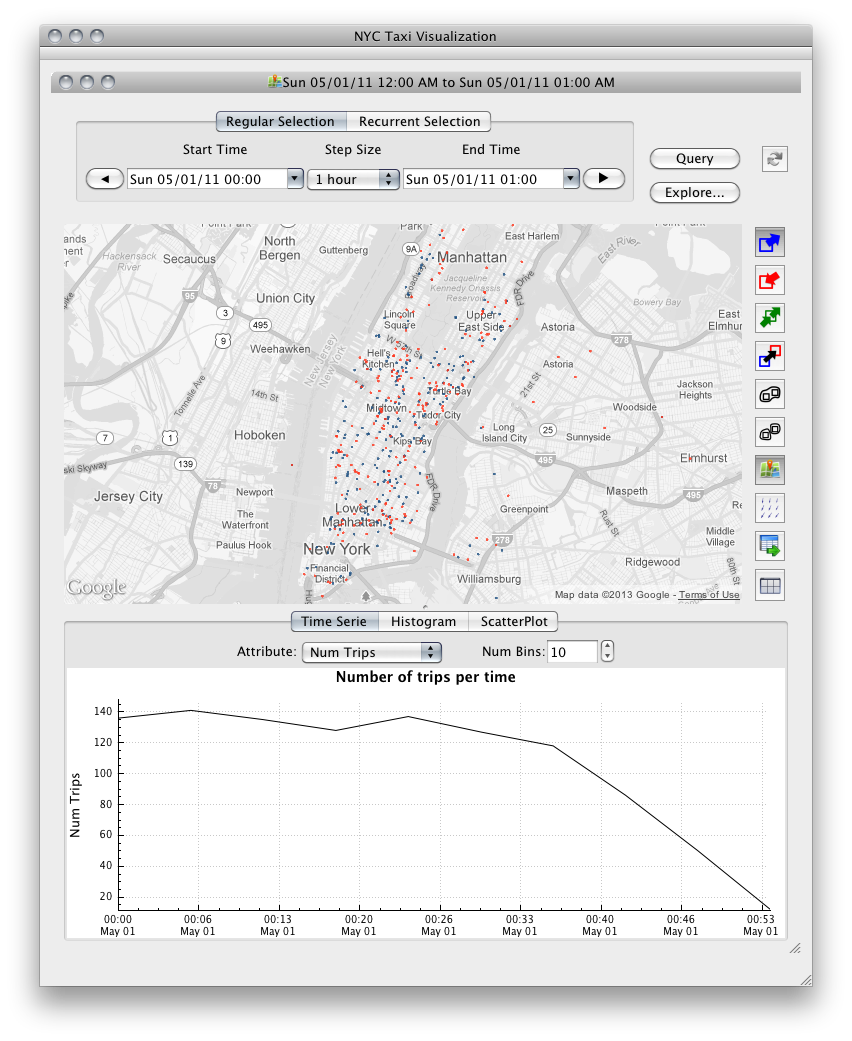
Advanced Temporal Queries: Recurrent Selection
The Challenge:
What if I want to see a pattern, not just a single time slice?
The Solution: Recurrent Selection
Select recurring time periods:
- All Mondays, 8am-10am
- Every Saturday night
- Weekday rush hours only
This reveals periodic behavior—the heartbeat of the city

Recurrent Selection Example
Question: “How do weekend nights differ from weekday mornings?”
Weekday Mornings (Mon-Fri, 7-9am)
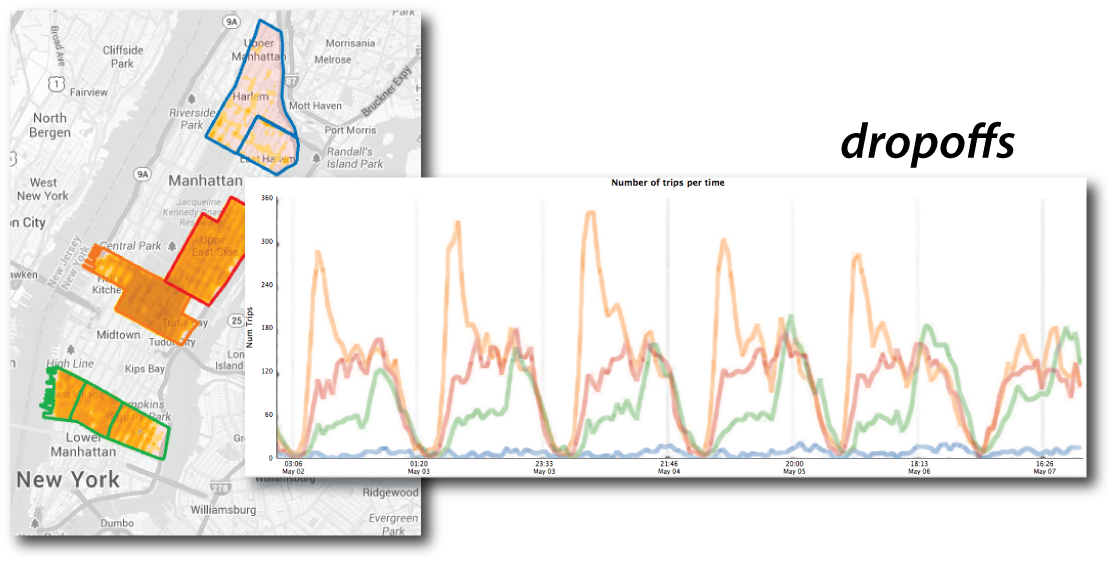
Inbound commuter patterns
Weekend Nights (Sat-Sun, 10pm-2am)
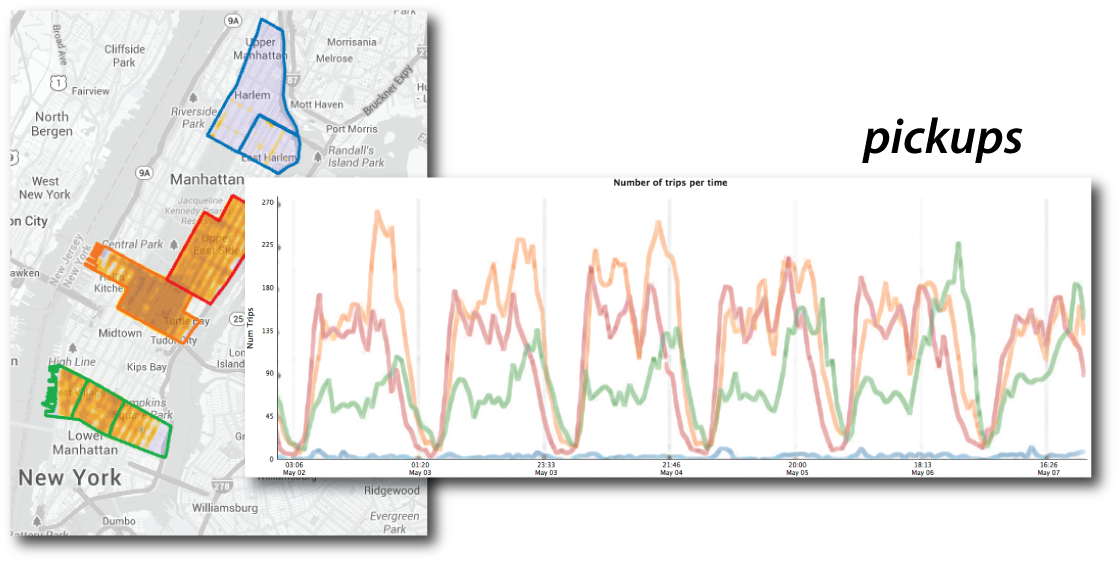
Entertainment district activity
Recurrent selection reveals systematic differences in urban activity patterns.
Part 15: Origin-Destination Queries
The Most Powerful Query: Flows
Asking about movement between specific locations
Traditional Approach:
Complex, requires knowing SQL and field names
TaxiVis Approach:
Draw an arrow
Simple, visual, intuitive
This is what we mean by “visual query”—you draw your question, the system answers.
The Arrow Tool: Step 1
Select the Arrow Tool

Arrow tool selected in toolbar
The arrow tool lets you create origin-destination (OD) queries by drawing directly on the map.
The Arrow Tool: Step 2
Draw Arrow from Origin to Destination

User drawing arrow from JFK to LGA
Example: Draw an arrow from JFK Airport to LaGuardia Airport to ask:
“Show me all trips that went from JFK to LGA”
The Arrow Tool: Step 3
All Views Update to Show Only That Flow

Dashboard showing only JFK→LGA trips
- Map highlights the origin-destination pair
- Time series shows when these trips occur
- Histograms reveal patterns in this specific flow
Visual Queries: Why They Matter
- Lower cognitive load
- No need to remember field names or syntax
- Direct manipulation of the data representation
- Immediate feedback
- See results instantly as you interact
- Iterate quickly through hypotheses
- Support exploration
- Encourages “what if” questions
- Makes serendipitous discovery possible
- Democratize analysis
- Analysts without SQL/programming skills can explore
- Domain experts can directly investigate questions
The visualization is the interface.
Part 16: Case Study 1 - Social Inequality
Question: “Are some neighborhoods underserved by taxis?”
The Analysis:
- Compare taxi activity across neighborhoods
- Midtown, Upper East Side, Greenwich Village, Harlem
- Look at pickups and dropoffs over one week


The Discovery: Over 10x Difference

Harlem vs other neighborhoods taxi activity
- Harlem has very few pickups despite many dropoffs
- People can take taxis TO Harlem but can’t get one FROM there
- Over one order of magnitude difference from Midtown
Follow-Up Investigation
The exploration followed a natural path:
- Initial pattern: Harlem has fewer pickups
- Hypothesis: Is this an economic issue?
- Investigation 1: “Are tips different in Harlem?”
- Discovery: Yes! Higher tips
- Investigation 2: “Is fare/mile different?”
- Discovery: Yes! Lower fare/mile
- Insight: Less economic incentive for drivers to go to Harlem, despite higher tips


Part 17: Case Study 2 - Transportation Hubs
Question: “How do people move through NYC’s transportation infrastructure?”
The Setup:
- Compare JFK, LGA, Penn Station, Grand Central
- Use grouping to combine regions
- Examine pickup patterns over one week

Key Findings
More pickups at LGA than JFK (most days)
Train stations >> airports for pickups
Weekday pattern: Train station pickups constant Mon-Thu, drop Fri-Sat
- Reflects commuter behavior
Rush hour problem: Airport trips take much longer 3-5PM
- Creates economic disincentive for drivers
- Explains why taxis illegally refuse airport trips
Part 18: Case Study 3 - Temporal Exploration
Time-Space Exploration
Feature:
- Select multiple time slices automatically
- Compare same time across different days/weeks/months
- Each slice gets its own map and plot line (color-coded)
Example: Memorial Day Analysis
- All Mondays in May 2011 and May 2012

Discovery: Memorial Day Pattern

Memorial Day vs regular Mondays
- Discovery: Memorial Day has significantly fewer trips than regular Mondays
- Implication: Could reduce fleet size on holidays to save costs
Part 19: Case Study 4 - Hurricane Sandy
Question: “How did Hurricane Sandy affect NYC?”
The Analysis:
- One week of taxi activity
- Sunday before through Saturday after
- Heat maps for each day
- Compare spatial patterns
The Timeline:
- Sunday (before): Normal activity
- Monday (hurricane hits): Virtually no taxis citywide
- Tuesday-Friday: Activity returns everywhere EXCEPT Lower Manhattan
- Saturday: Finally returns to normal
The Story the Data Tells

Daily heat maps showing Hurricane Sandy impact
Why? Lower Manhattan had a 5-day power outage
You can literally see the power outage on the map.
Comparison to Hurricane Irene
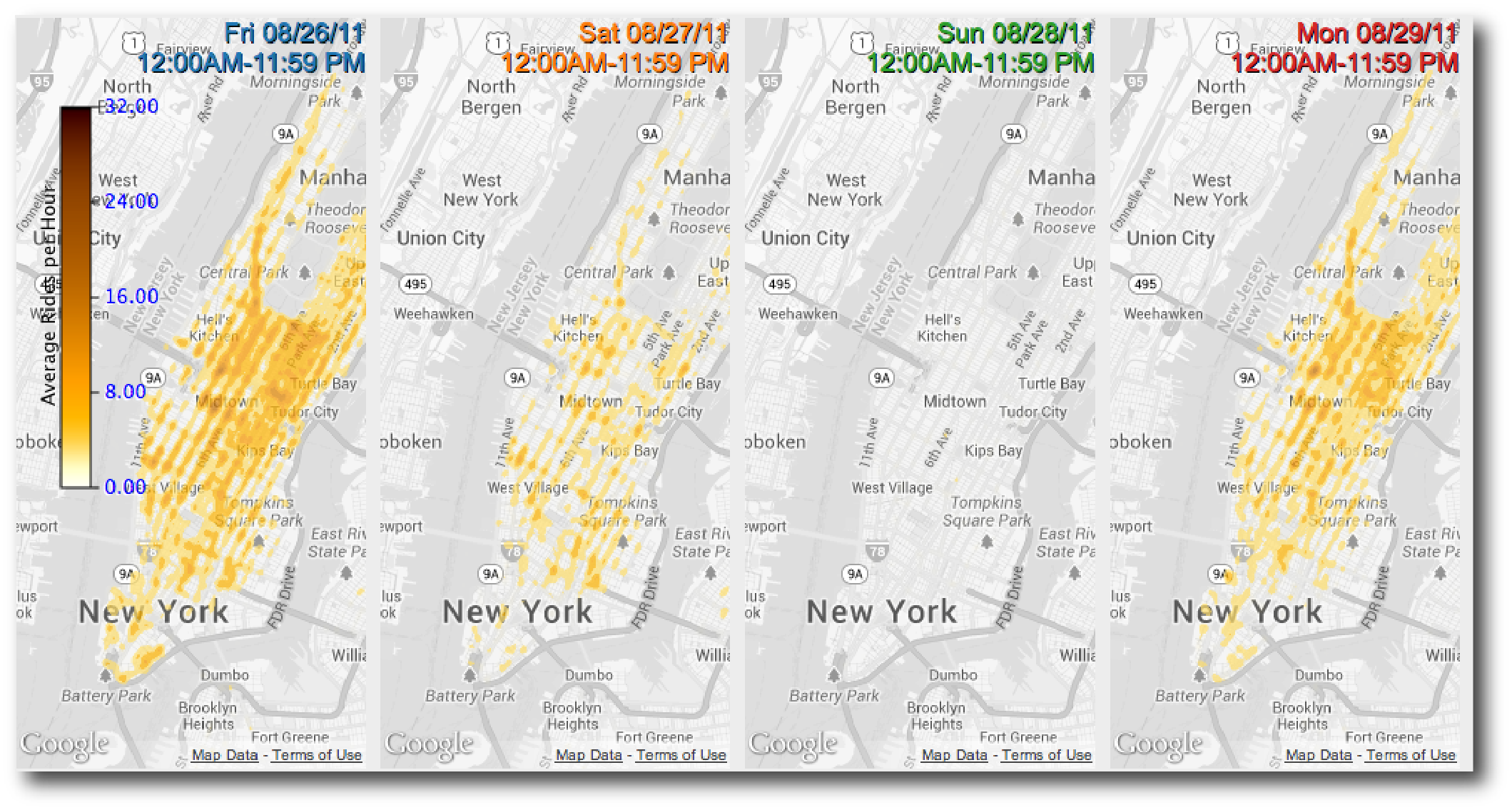
Hurricane Irene impact on taxi trips
- Shorter disruption but more complete
- Only 1,076 trips on hurricane day (vs. average 500,000)
- Faster recovery
Part 20: What We Learned
Design Insights from Building TaxiVis
- Visual queries work
- Domain experts could use it without training
- No SQL, no programming required
- Performance is non-negotiable
- Sub-second response enables exploration
- Adaptive rendering essential for large results
- Multiple views are essential
- Comparison is core to analysis
- Side-by-side queries, synchronized views
- Linked plots and maps
- Query composition is powerful
- Build complex queries from simple ones
- Grouping, refinement, generalization
Part 21: Real-World Impact
Who’s Using TaxiVis?
Users:
- NYC Department of Transportation
- NYC Taxi & Limousine Commission
- Traffic engineers and urban planners
- Economists studying urban mobility
What They’ve Learned:
- Social inequalities in taxi service (Harlem)
- Economic incentives affecting driver behavior
- Impact of major events on city mobility
- Transportation hub usage patterns
Beyond Taxis:
- Model applies to other origin-destination data
- Generalizes to other spatio-temporal datasets
- Principles useful for any urban data exploration
Part 22: Key Takeaways
The Big Ideas
- Urban data is fundamentally spatio-temporal
- Space, time, and attributes all matter
- Need to explore interactions, not just individual dimensions
- Static visualization is not enough
- Interactivity transforms presentation into exploration
- “Dialogue with data” through visual queries
- Design for domain experts, not data scientists
- Visual operations instead of code
- Direct manipulation over programming
- But don’t sacrifice expressiveness
- Performance enables exploration
- Sub-second response changes how people think
- Specialized systems beat general solutions
- Trade generality for interactivity
Part 23: From TaxiVis to Urban Analytics
The Broader Vision
TaxiVis is One Example
Other urban data:
- Bikeshare systems
- 311 service calls
- Building permits
- Transit ridership
- Crime reports
- Traffic sensors
Same challenges: Scale, complexity, spatio-temporal nature
The Visual Analytics Framework

- Visualization: Multiple representations and query models
- Data Analysis: Topology, ML, pattern detection
- Data Management: Specialized indices, GPU acceleration
Moving to 3D
Cities are vertical, not just horizontal
- Shadow analysis
- Views and sight lines
- Sky exposure
- Building massing
Next Lecture:
We’ll extend these ideas to 3D urban visualization and the Urbane framework
Same principles apply: interactive, visual, scalable
Summary
The Visual Analytics Pipeline for Urban Data
What We’ve Covered Today:
The Problem:
- Urban data is big, complex, spatio-temporal
- Traditional tools don’t scale
- Confirmation vs. exploration gap
The Solution:
- Visual query models for direct manipulation
- Interactive performance through specialized systems
- Multiple visualizations for different questions
- Comparison through coordinated views
The Result:
- Domain experts can explore without programming
- Discoveries about social inequality, economics, events
- Real impact on city operations and policy
Try It Yourself - Exploration Exercise
If you had access to TaxiVis, what would you explore?
Think about:
- A neighborhood you’re curious about
- A time pattern (weekday vs. weekend, holidays, events)
- A comparison (this year vs. last year, two locations)
- A hypothesis about urban behavior
Discussion:
- What question would you ask?
- What spatial regions would you select?
- What time slices would you compare?
- What would you expect to find?
Questions?
Next week: 3D & Immersive Urban Visualization
Preview:
- Urbane framework for 3D urban planning
- Interactive impact analysis (shadows, views, sky exposure)
- Performance-driven architectural design
- When to use 3D (and when not to)
